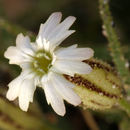Comments
provided by eFloras
Silene sargentii is very similar to S. suksdorfii, but that species has purple-septate hairs on the calyx and pedicels, whereas those on S. sargentii are colorless (see M. A. T. Showers 1987). Also, the cauline leaves of S. suksdorfii are narrowly oblanceolate rather than linear, and the basal leaves are marcescent. Silene sargentii may be confused with S. bernardina and can intergrade with it in Nevada. However, that species is usually larger with a longer, tubular calyx and petals that are deeply divided into 4-6 narrow lobes, unlike S. sargentii, which has 2-lobed petals.
- license
- cc-by-nc-sa-3.0
- copyright
- Missouri Botanical Garden, 4344 Shaw Boulevard, St. Louis, MO, 63110 USA
Description
provided by eFloras
Plants perennial; taproot stout; caudex much-branched, woody, producing many decumbent, leafy, short shoots and erect flowering shoots, often densely cespitose. Stems erect, decumbent at base, simple, branched in flowering region, slender, 10-20(-25) cm, sparsely pubescent and glandular. Leaves mostly basal; basal marcescent, densely tufted, long-petiolate, blade linear-oblanceolate, 1-3 cm × 0.5-3 mm, somewhat fleshy, setose-puberulent on both surfaces; cauline in 1-3 pairs proximal to inflorescence, reduced distally, blade linear, 1-4 cm × 0.5-2 mm. Inflorescences 1-3-flowered, with terminal flower, usually with 1 or 2 flowers at proximal nodes. Pedicels erect, sometimes slightly bent at apex, 4-2 times calyx, viscid glandular-puberulent, septa of hairs colorless. Flowers: calyx prominently 10-veined, narrowly campanulate, ± umbilicate, not contracted proximally around carpophore, 9-18(-22) × 3-6 mm, papery, glandular-puberulent, viscid, hairs with colorless septa, veins parallel, purple, with pale commissures, lobes with midrib present, triangular, 2-3 mm, margins purple tinged, membranous, often broadened distally into round, crenulate lobe; corolla off-white, usually pink or purple tinged, to 1 2 times longer than calyx, limb 2-lobed, 2-3 mm, sometimes with 2 small lateral teeth, appendages 2, ovate, 1-1.5 mm; stamens slightly longer than calyx; styles 3(-5), equaling petals. Capsules included in calyx, opening by 6 (or 8 or 10) ascending teeth; carpophore 1.5-3 mm, woolly. Seeds brown, reniform, ca. 1.5 mm, rugose on both surfaces, margins with large, inflated papillae. 2n = 48.
- license
- cc-by-nc-sa-3.0
- copyright
- Missouri Botanical Garden, 4344 Shaw Boulevard, St. Louis, MO, 63110 USA
Distribution
provided by eFloras
Calif., Idaho, Nev., Wash.
- license
- cc-by-nc-sa-3.0
- copyright
- Missouri Botanical Garden, 4344 Shaw Boulevard, St. Louis, MO, 63110 USA
Habitat
provided by eFloras
Alpine grassy, gravelly, or rocky slopes and ridges, openings in subalpine forests, sagebrush, and on juniper slopes; 2400-3800m.
- license
- cc-by-nc-sa-3.0
- copyright
- Missouri Botanical Garden, 4344 Shaw Boulevard, St. Louis, MO, 63110 USA
Synonym
provided by eFloras
Lychnis californica S. Watson; Silene lacustris Eastwood; S. watsonii B. L. Robinson
- license
- cc-by-nc-sa-3.0
- copyright
- Missouri Botanical Garden, 4344 Shaw Boulevard, St. Louis, MO, 63110 USA
Silene sargentii: Brief Summary
provided by wikipedia EN
Silene sargentii is a species of flowering plant in the family Caryophyllaceae known by the common name Sargent's catchfly. It is native to the western United States, where it is known from the mountain ranges straddling the California-Nevada border east of the Sierra Nevada. It is also known from one disjunct occurrence in central Washington. It grows in rocky mountain habitat in subalpine and alpine climates. It is a perennial herb growing from a woody, branching caudex and taproot, sending up several decumbent or erect stems and shoots. It grows no more than about 20 centimeters tall, often taking a clumpy form. The fleshy leaves are widely lance-shaped and a few centimeters in length, most of them occurring around the caudex. Each flower is encapsulated in a hairy, glandular calyx of fused sepals which has stark purple veining. The petals are white to deep pink and each has two or more rounded or pointed lobes at the tip.
- license
- cc-by-sa-3.0
- copyright
- Wikipedia authors and editors

